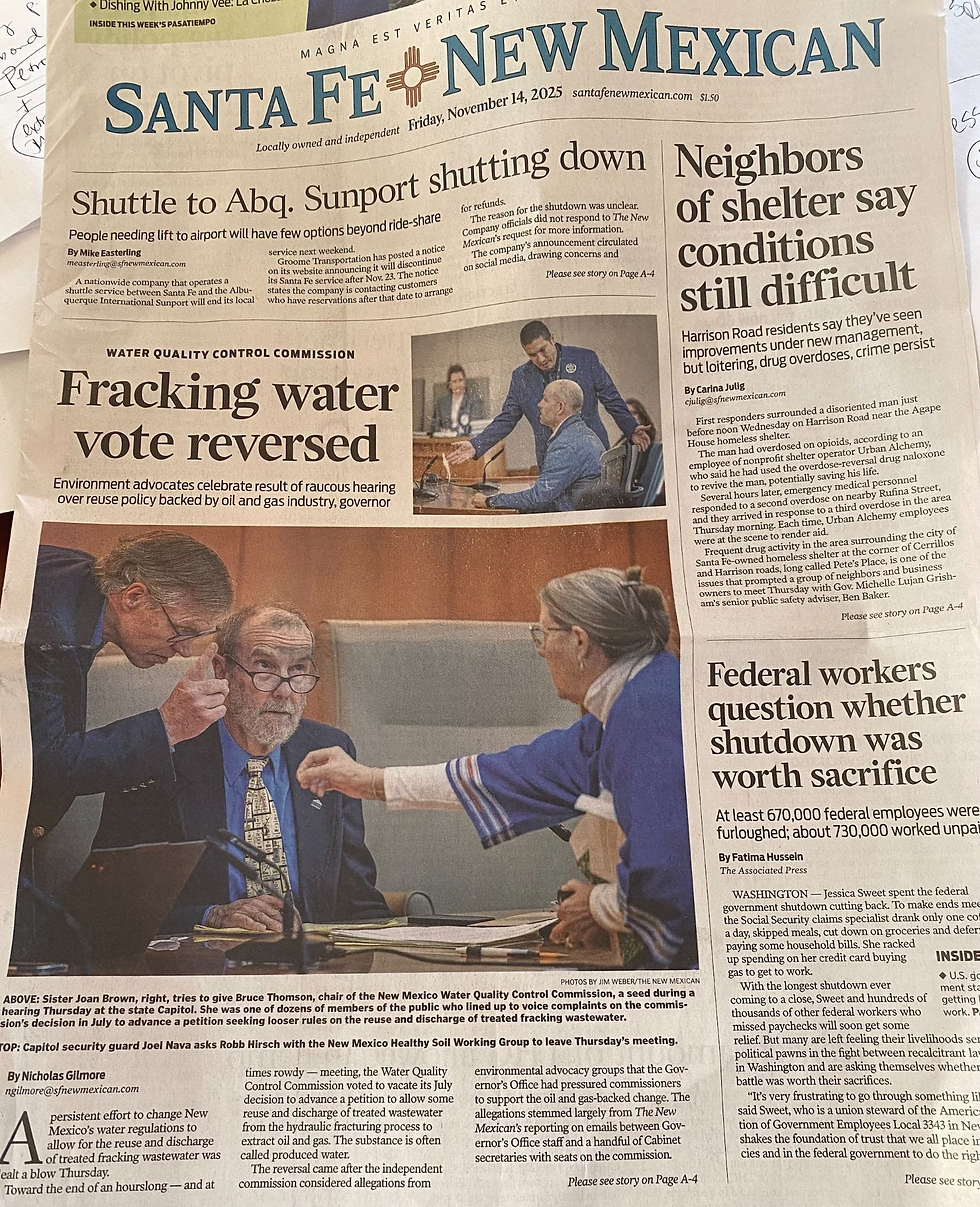Governor's Strategic Water Supply on life support
- New Energy Economy

- Feb 12, 2024
- 4 min read
With your help, and with a unified voice from environmental and water protection groups across the state, we have succeeded in convincing legislators that the Governor's "Strategic Water Supply" plan to introduce treated fracking waste into our water supply is a dangerous proposition. As reported in the Source this morning, Senator George Muñoz, Chair of the Senate Finance Committee told the reporter that the measure was removed from the capital outlay package, which is scheduled to go before the Senate Finance Committee today. As the Senator himself said, the idea of making brackish and produced water a commodity is “absolutely scary.” The plan can now only pass as a standalone bill rather than approval through the capital outlay process.
So where do things stand now? A dummy bill, SB 294 has been amended to include $100M for treatment of brackish water and will be heard first thing tomorrow in Senate Conservation. The new bill does not mention produced water from fracking waste, but still merits significant concern, especially because the connections between deep brackish water aquifers and potable groundwater aquifers in New Mexico are not well understood. Hydrologists are concerned that these deep aquifers cannot be replenished and that drilling could compromise our potable water resources. Any plan to subsidize extraction and treatment of brackish water requires study and careful review before implementation. With three days left in the session that is a tall order! Some questions we have:
● Do we have an adequate characterization of our aquifers statewide for such a proposal?● How will pumping deep brackish water impact shallow potable water aquifers and surfacewater resources? Has this review been done and if not who sets requirements and approves thisanalysis before new pumping can commence?
● Brackish water occurs in shallower aquifers in many areas across the state and has beencommonly used for agriculture and livestock. How will this water that is already in use bedifferentiated from the saline water to be pumped for the Strategic Water Supply?
● Has it been determined how this new effort would impact agricultural producers and if thereare any potential impacts to our Compact obligations?
● How will concentrated waste from the treatment process be addressed? Who will cover thecosts of this disposal and what science will be used to ensure best practices on treating brackishwater solids?
● The State Engineer does not issue water rights permits for deep non-potable water, with someexceptions for declared basins. Will this proposal change that and should the OSE have a role in issuing water rights permits for brackish water?
● Has brackish water been defined in statute or rule? NMED protects all groundwater 10,000mg/L total dissolved solids or less equally. Water with less than 1,000 mg/L total dissolvedsolids is generally considered safe for human consumption. Does this proposal assume therewill be different water quality standards for brackish water between 1,000 and 10,000 TDS? Isit wise to create new categories of water and disregard long-standing water quality protections?
● The 2022 Water Policy and Infrastructure Taskforce, a diverse group convened by the Governor, made over 100 recommendations, developed through consensus, related to New Mexico’s water future. How many of these recommendations remain unfunded?
NOW PLEASE TAKE ACTION TO PREVENT ANOTHERBIG AG/BIG OIL GREENWASHING SCHEME
Like "Clean" Coal, the "Clean Fuels" being proposed in HB41 amount to a dirty lie. As we reported last week, the Clean Fuel Standards Act is primarily a scheme to prop up the biofuels and hydrogen industry, a plan the sponsors admitted during the Senate Conservation hearing last week. Unfortunately the bill passed that committee and the House floor, and our only hope now lies again in Senate Finance or on the Senate floor. It is on the schedule for today but is likely to be rolled because it is last on the agenda. Your action now is critical.
When asked about the connection to methane sourced from dairy farms, HB41 sponsors suggest that the dairy farms in New Mexico are not equivalent to the giant dairy farms in California profiting from sales of methane gas, but they fail to mention that the Low Carbon Fuel Standard in California increases emissions by repackaging methane from the manure of out-of-state dairies as "clean fuel" and importing this so called Renewable Natural Gas into the state to earn carbon credits. As the excellent report we cited last week put it:
Public investment pouring into factory farm gas is creating perverse incentives, where animal agriculture could become more about maximizing manure production over animal products. The system itself depends on generation of emissions to remain financially viable, doing nothing to reduce emissions from the source. By locking in existing herd sizes and even incentivizing expansion, increasing biogas investment risks parallel increases in greenhouse gas emissions.
More than 80% of the clean fuel credits sold in California in 2022 went to these biofuel producers. As we know emissions anywhere will impact our climate, whether they come from in state or out of state sources.
HB41 sponsors also touted the benefits of the Clean Fuel Standard Act to incentivize the hydrogen fuel cell industry.
In other words these so-called "clean fuels" are just one more false climate solution that serves only to prop up industry and delay the investment and action on renewable energy expansion that we need. Please act today to ask Senate Finance to VOTE NO on HB41.









Comments